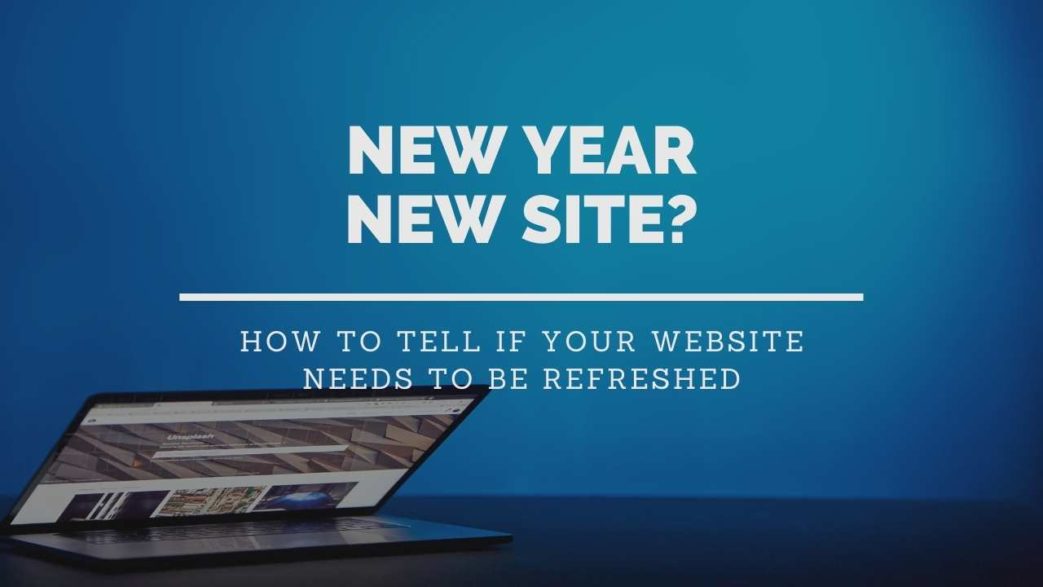Estimated reading time: 10 minutes
It’s a brand new year, so does that mean you need a new site for your church?
A new year often means looking back at various things in your life to see what you can change and improve. Your church website should definitely be one of them.
As fast as technology changes, there’s a good chance your site could use a refresh. Depending on how long it’s been, you may even want a completely new website.

Table of contents
- Your Search Rank Is Falling
- It Looks Dated Next To Other Churches
- Visitors Aren’t Sticking Around
- It Doesn’t Look Great On All Devices
- It Doesn’t Load On All Browsers
- The Site Loads Slowly
- Your Site Isn’t Secure
- Your Content Is Extremely Outdated
- You Haven’t Made Any Changes In Years
- It’s Hard To Navigate Your Site
- It’s Hard To Manage Your Site
- There Are Inconsistencies
- Your Site Isn’t Helping With Growth
- It’s Too Simple Or Too Complex
Your Search Rank Is Falling
One of the top reasons your church probably created a website is to help with growth. However, if your site isn’t ranking highly, you won’t see much growth at all. If your rank is slowly or even suddenly declining, it could be a major sign that you need a new site.
Of course, if you’ve had a site redesign recently, it could also be issues with SEO. If you haven’t had a refresh, the design itself may contribute to the SEO issues as well.
If you’re not sure how to optimize your church site for SEO, try these guides we’ve created:
- Everything Your Church Should Know About SEO
- The Ultimate SEO Guide For Churches
- The Secrets To Better Local SEO For Churches
- Best Free SEO Tools For Churches
It Looks Dated Next To Other Churches
Take a look at some of the most popular church websites. How does your compare?
While it definitely shouldn’t look identical, do other church websites make your site look dated? Maybe the colors seem brighter and the navigation flows better. Other sites might have features you’ve never even thought about before.
If your site looks dated, it’s not going to make a great first impression. To visitors, a dated site seems like your church isn’t interested in maintaining itself. While this isn’t true, people who experience your church through your site for the first time only have your website to judge you by.
A commonly cited statistic is people tend to form an opinion of a website in just 50 milliseconds. The statistic is rather old, but it is true that first impressions are formed quickly. A dated site gets judged harshly and may make visitors leave.
Visitors Aren’t Sticking Around
Do you open your website only to hear crickets in the background? Where have all your visitors gone? Maybe it’s time for a new site for your church.
When your site’s visitors start to fade away, you should immediately take notice. It could be the site itself just isn’t engaging them anymore. For instance, it might work on a new device or browser. Or, there’s no new content to interact with.
Over time, your site might also slow down to the point that visitors don’t have the patience to stick around. No matter what the reason, it’s definitely time for a website refresh.
Ask some of your church members to help you pinpoint what’s going wrong. Ask members of all ages to check out your church site and write down why they loved and hated. This can help you figure out where to start making changes.
It Doesn’t Look Great On All Devices
Mobile Internet users account for 91% of all Internet users as of 2020. Of course, this doesn’t mean many of those don’t use desktops or laptops as well. But, the lesson here is if your church website isn’t optimized to look great on all types of devices, it’s time for a new site.
Mobile devices aren’t a passing fad and having a mobile-friendly site isn’t optional anymore. Now, you need a responsive site that adjusts for desktops/laptops, tablets and smartphones.
Of course, this also means adjusting for the wide variety of screen sizes and shapes. If your site looks great on on smartphone, but terrible on another, you could lose any visitors using the latter device.
There are ways to quickly check if your church’s site is mobile-friendly. If it’s not, give your site a major refresh with a responsive design. Then, you’ll be able to better reach the over four billion mobile Internet users.

It Doesn’t Load On All Browsers
Much like with devices, your church site needs to work on all browsers. It’s not uncommon for there to be an occasional glitch if a visitor is using a lesser known browser. However, your site definitely needs to be compatible with Chrome and Chromium-based browsers, Firefox, Edge and Safari.
Browsers change over time to offer users a better experience. This means different HTML standards change too. If your site isn’t up to date, it might not display correctly, causing visitors to leave. For example, if your site isn’t optimized using the latest version of HTML5, it might not show up correctly in the majority of Internet browsers.
The easiest way to check, of course, is to open your site in the major browsers. Check all major features, such as navigation, links, embedded videos, image loading and anything else beyond basic text.
The Site Loads Slowly
How annoyed to you get when a site you want to visit takes more than few seconds to load? In the age of instant gratification, visitors want everything to happen instantly. Whether it’s a website loading or being able to buy new clothes online, they want things happening as quickly as possible.
Waiting is one of the worst things you can ask your site visitors to do. If it’s taking a while for pages, images and videos to load, visitors won’t stick around to see the amazing content they’re missing. They’d rather spend the time searching for another site.
You only have a seconds before visitors leave. Check your site. If it’s not loading quickly, it’s time for a new site. By changing the design, code and image sizes, you can drastically boost your loading speed. You’d be surprised at all the various things that actually slow your site.
Your Site Isn’t Secure
There are two things to consider here – your website’s overall security and your site’s security certificate. Both affect user experience and church’s your search rank.
First, let’s talk about overall security. If your site isn’t secure, it can drive visitors away. They might get redirected to malicious sites if your church website is hacked. While no one can guarantee a hacker won’t get into your site, there are a variety of ways to create a more secure site.
If security issues are happening frequently, though, it’s a good sign that you need a new site. Outdated code, themes, and your core WordPress platform can all hurt your site. But, refreshing your site helps you bounce back and improve security.
Second, having an SSL certificate helps show visitors that your site is safer. While malicious sites can have an SSL certificate, it’s still something simple that makes visitors feel better. Plus, sites with HTTPS rank higher than those without it.

Your Content Is Extremely Outdated
If you’re not updating your content, your website probably hasn’t had an update in a while either. Look back at when the last time you updated your homepage content was. How often do you blog?
Imagine if a clothing website never updated the images and product listings on their site. As fashion trends changed, the clothing site would get forgotten because they never offered anything different.
The same applies to your church site. If you’re not updating your content and your site’s design, it gets left in the past.
Create a regular blogging schedule, refresh content throughout all your pages and give your church’s site a nice makeover. All of this makes your site look and perform better.
You Haven’t Made Any Changes In Years
It’s a new year, so it’s finally time to do what you’ve been putting off for years – getting a new site. Trends and technology change every year. For each year that you’re not adding or changing a few things about your site design, the older it looks.
The great news is you don’t always need a brand new website every year. Simple tweaks, such as a new theme, rearranging content or adding something related to a new trend, make a major difference.
It’s Hard To Navigate Your Site
Visitors want a site that’s instantly easy to navigate. They don’t like searching around for things. It should be intuitive and simple. For instance, skip those large multi-level menus with dozens of options with dozens of sub-options.
If your navigation looks more like one of those bulky menus from the late 90s or early 00s, a new site design could really help modernize your church’s site.
Plus, your site suddenly becomes easier to use. That also keeps people on your site longer.
It’s Hard To Manage Your Site
While your visitors have no idea how difficult or easy it is to manage your website, you do. Often, this is why church websites, and websites in general, aren’t updated like they should be. The behind the scenes management is just too hard.
For example, if it takes hours just to figure out how to upload a simple blog post, you’re probably not going to blog often. If you can’t rearrange content blocks without hiring a developer to do it, you may just let your design look dated rather than spending more money.
Of course, there’s also the regular maintenance too, such as performing updates to plugins and themes. If it’s not easy to do, you’re less likely to keep your site updated and secure.
With a new church website, you can switch to a platform that’s much more user-friendly. For instance, Reach Right Studios uses WordPress, which gives you much more control when it comes to updating content, installing updates and making various design changes. Naturally, we’re always happy to help with any design changes you want to make.

There Are Inconsistencies
When you jump from page to page, does it look like completely different websites? Often, when site owners refresh their sites, they only refresh portions. They might add a new section or set of pages. Or, they’ll just update certain pages.
The problem is, you end up with noticeable inconsistencies that can drive visitors away. For example, if a visitor opens your church’s homepage and then visits your sermons page, but the two look nothing alike, they might not feel safe. To them, it looks like a completely new site, which is often what happens with hacked sites.
Colors, fonts, important details (such as service times, if they’ve changed), design scheme and more need to be consistent throughout your entire site. Do this and visitors stay longer, which helps boost your rank.
Your Site Isn’t Helping With Growth
Is your church’s website doing anything to boost your growth? If not, it might be time to rethink your website. It could be outdated, need an SEO overhaul or just need fresh content.
Making changes regularly keeps your site fresh. This keeps visitors coming back. With regular visitors, you also get regular recommendations online, such as a visitor sharing a blog post on social media. All of this adds up to growth, both offline and online.
It’s Too Simple Or Too Complex
If you’re on an extremely tight budget, you might have opted for an extremely simple site that’s just a few pages. While this is okay at first, it’s a good idea to expand over time. Add new pages and features year after year until your site has everything visitors expect, such as contact details, info about your church’s history, recent sermon videos and a blog. Definitely make sure you have these six pages.
On the other hand, if your have too much on your church site, it’s time to scale back. Throwing too much information at your visitors or having so many pages that it’s difficult to find anything is even worse than a few simple pages.
Talk with your members to see how they feel. Is there information or features missing? Does it seem like your site has everything and a few unnecessary kitchen sinks?
You can also check out other church websites to see what they’re doing. This will help show you how to achieve a better balance as you refresh and build a new site.
Is it time for a new church site? Contact us today to create a completely new website or make some changes for a fresh new look for the new year.




